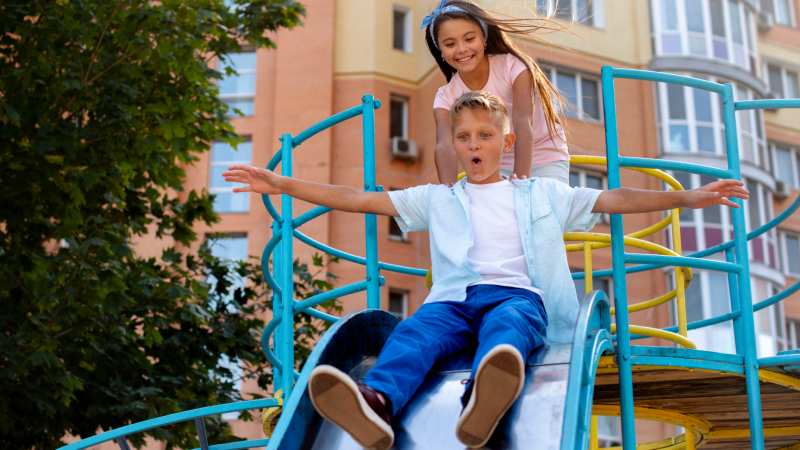Playgrounds have always been magical places—spaces where children test their boundaries, spark their imaginations, and build friendships. But behind the giggles and games, a well-designed playground should also serve a greater purpose: keeping children safe. Safety and fun aren’t opposites. In fact, the most successful playgrounds balance creativity and protection so kids can explore freely while parents and caregivers can relax.
Whether you’re planning a community park, a school play area, or a backyard setup, prioritizing safety is essential. Here’s how thoughtful design can elevate a playground from “fun” to “joyfully unforgettable—and safe.”
Start With Smart Layout Planning
A safe playground begins long before equipment arrives—it starts on paper. Good layout planning not only organizes the space but also creates clear zones based on age group and activity level.
- Separate active and quiet areas. Place high-energy features like swings, slides, and climbers away from slower activities like sandboxes or reading nooks. This prevents fast-moving kids from colliding with those engaged in calmer play.
- Consider sightlines. Parents and supervisors should be able to scan the entire space easily. The fewer blind spots, the better the supervision.
- Allow proper spacing between equipment. Adequate clearance helps prevent accidental collisions. Swings need a wide, unobstructed arc, while slides should have enough landing space.
Thoughtful planning ensures that play flows smoothly and helps minimize accidents before they happen.
Choose Age-Appropriate Equipment
Kids of different ages play differently, so one-size-fits-all equipment doesn’t always make sense. Matching playground elements to developmental stages reduces risks and keeps things engaging.
- Toddlers (2–5 years): Low platforms, short slides, and stable climbing structures support balance and early motor skills.
- Older kids (5–12 years): Taller climbing walls, monkey bars, rope bridges, and more challenging obstacle courses help build strength and coordination.
Label equipment zones and use signage to help adults guide children to appropriate play areas.
Install Shock-Absorbing Surfaces
Even in the safest playgrounds, slips and tumbles are bound to happen. The goal isn’t to eliminate every fall—it’s to reduce the chances of injury when they occur. Hard ground surfaces like concrete or compacted dirt don’t provide enough cushioning and should be avoided.
Instead, choose impact-absorbing materials such as:
- Rubber tiles
- Poured-in-place rubber surfacing
- Wood mulch or engineered wood fiber
- Rubber mulch
- Large bark (a popular, natural loose-fill option often used in Salt Lake City playgrounds and parks)
These surfaces help soften falls and distribute impact more safely. For loose-fill materials like wood mulch or large bark, aim for a depth of at least 12 inches, especially under equipment such as swings, climbers, and slides. No matter which material you select, regular maintenance—fluffing, leveling, and refilling as needed—is essential to keep the surface safe and effective.
Safeguard With Proper Equipment Design
The best playground structures are intentionally engineered to reduce hazards. When selecting equipment, look for important safety features:
- Rounded edges instead of sharp corners
- Guardrails and barriers on elevated platforms
- Hand grips and non-slip steps to prevent slipping
- Secure fasteners and capped hardware to reduce snagging on clothing or skin
Additionally, choose materials that withstand weather—UV-resistant plastics and rust-proof metals hold up better and stay safer over time.
Think Beyond Equipment: Add Comfort and Accessibility
Safety extends beyond preventing injuries—it includes designing a space where every child feels welcome and comfortable.
- Shade structures protect kids from sun exposure.
- Smooth, wide pathways allow children who use mobility devices to access every part of the playground.
- Benches and seating give caregivers a place to stay close and supervise.
Incorporating inclusive features shows that safety isn’t just physical—it encompasses emotional and social well-being too.
Create and Maintain Clear Safety Rules
Rules don’t shut down fun—they make sure it lasts.
Examples of effective playground rules:
- Use equipment one at a time.
- Go down the slide feet first.
- Keep a safe distance from moving swings.
- No pushing, shoving, or rough play.
Posting simple, easy-to-read signs encourages kids to play responsibly and gives adults predictable guidelines to reinforce.
Commit to Regular Inspections and Maintenance
Even the best-designed playground can become unsafe without ongoing care. Make inspection and maintenance part of the long-term plan.
- Check for loose bolts and worn ropes.
- Rake loose-fill surfacing regularly to maintain depth.
- Repair or replace broken equipment promptly.
- Clean and sanitize high-touch surfaces.
A safe playground isn’t a one-time installation—it’s an ongoing commitment.
Final Thoughts: Safety Unlocks Joy
When safety is woven into every aspect of playground design, children gain the freedom to take healthy risks, discover new abilities, and experience pure joy. A safe playground invites laughter, builds confidence, and brings communities together.
Create a space where parents feel secure, where children play boldly, and where every moment is both exploratory and protected. After all, the best playgrounds aren’t just built to entertain—they’re designed to help kids grow, thrive, and dream.

